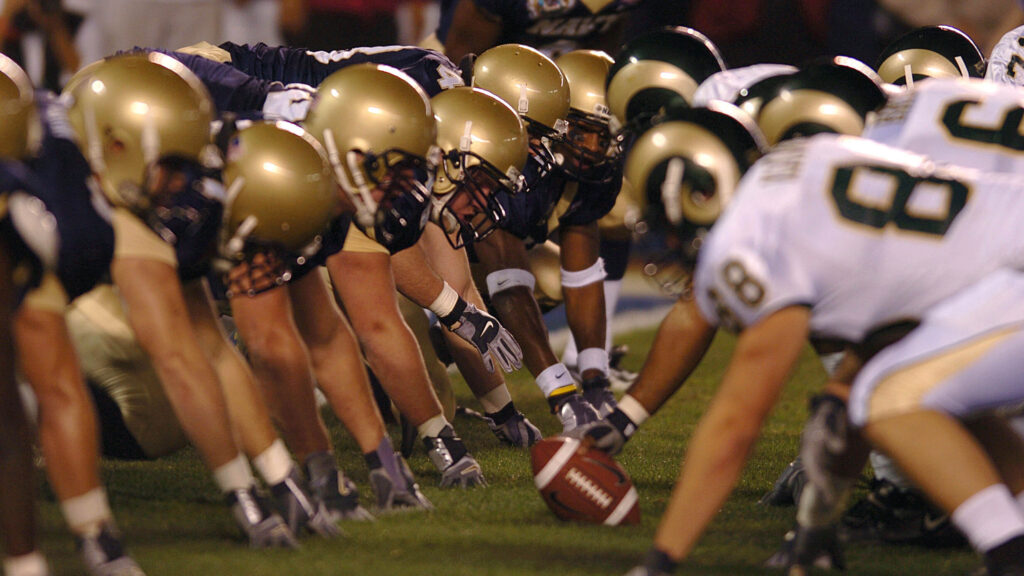by The Cowl Editor on November 9, 2017
Opinion

by Katherine Torok ’20
Opinion Staff
Fall is arguably the most beautiful season to experience in New England. Vibrant fire-colored trees line the sides of small backroads, crisp air stirs some fallen leaves around, and the cheers of football fans are heard throughout small towns and big cities every Sunday night.
For many years, professional football has been dubbed as “America’s favorite sport,” surpassing other all sports such as baseball and basketball. Even on the Providence College campus, it is hard to go a day without a large handful of students sporting some type of New England Patriots apparel. Yet, why is America so in love with a sport that causes deadly mental illnesses?
The National Football League has been in the spotlight for the past few years, as doctors and the media have started to seriously press the league about the issue of concussions and head trauma more and more. The NFL has since then implemented various new rules and hefty fines in order to keep their players safer. However, this does not mean that American football players are entirely protected.
In 2015, America was given a harsh reality check when the biographical sports movie, Concussion, starring Will Smith, was released. The movie proved to Americans, and the world, just how damaging and life threatening concussions are to athletes, especially those who play football. In a sport like football, in which players receive constant blows to the head, repeated concussions can lead to a degenerative brain disease known as CTE, or Chronic Traumatic Encephalopathy. Symptoms of CTE include erratic and impulsive behavior and have caused retired NFL players, like safety Ray Easterling, linebacker Junior Seau, and defensive back Dave Duerson to commit suicide.
Monday, October 30, marked the beginning of Providence College’s Mental Health Awareness Week. The week was devoted to both spreading mental health awareness around campus and showing support for peers. Mental illness is not something that should be taken lightly in any way. In general, the most common mental illnesses found in college students are depression, anxiety, eating disorders, and addiction. In retired pro-football players, the most common mental illnesses include conditions similar to Alzheimer’s disease, erratic behavior, and depression.
Although symptoms of professional football players share mental illnesses similar to college students, there is one big difference between the two of them—CTE. College students typically do not develop their mental illnesses as a symptom of CTE, unlike pro-football players who do. CTE is caused by repetitive brain trauma, meaning it is fair to blame pro-football players’ crimes, murders, and suicides on their CTE developed from playing in the NFL.
Why do Americans find such joy and entertainment in watching football players slowly destroy themselves?
Maybe it is because of the action and thrill that comes with the game itself, as players purposely throw themselves around in order to stop the ball from entering the end zone. Maybe people enjoy the social aspect that comes with football too, such as team rivalries and super fan groups like “Pats Nation.” Maybe it is simply because it is an all-American sport and has become an iconic part of American culture.
Regardless of why certain people find football entertaining, it is impossible to disregard all of the health studies and facts conducted and gathered over the years.
Although injuries during a football game can be severe, the mental illnesses that develop in the years after a player stops participating on the field can be just as detrimental, or even worse. But that is not going to stop Americans across the nation from tuning into Sunday Night Football almost every weekend.
It is impossible and unreasonable to outlaw contact football at the professional level and other levels of play. But the long term health issues that come with playing such an intense sport really need to be better recognized. The nation also needs to reevaluate how much money the NFL is making and how much they are putting into solid and effective concussion research.
Although these changes will not happen magically over night, they are just some things to keep in mind as years go on and more and more former football players suffer.
Just remember, even though NFL players may be living successful lives with every hit to the head, their future becomes darker and more uncertain.